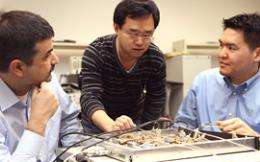Project Helping Shape Future of 4G Wireless Communications

(PhysOrg.com) -- Key elements of the next-generation of mobile technology are under development at UT Dallas, promising better Internet access, lightning-fast downloads and seamless global roaming.
A two-year project focuses on the advanced algorithms required to orchestrate the complexities of fourth-generation, or 4G, communications. Those complexities arise in part from what’s known as MU-MIMO - multi-user, multi-input, multi-output technology - and particularly from the proliferation of antennas.
Your basic walkie talkie had just one antenna. But soon your cellphone and the person’s you’re calling will each have multiple antennas inside, and each cellular base station will also have multiple antennas. Optimizing the communications in such a situation is not trivial.
“In order to realize the full benefits of MU-MIMO for 4G devices, new ideas and techniques must be developed,” said Murat Torlak, an associate professor of electrical engineering in the Erik Jonsson School of Engineering and Computer Science at UT Dallas and principal investigator on the project. “In particular, effective and novel real-time algorithms with excellent complexity/performance tradeoffs must be implemented.”
Torlak’s team is one of four groups in the nation working on an effort co-funded by National Instruments that involves the implementation of real-time algorithms for software-defined radio, cognitive radio and other communications applications. The others are at the University of California, Berkeley; Virginia Tech; and UT Austin.
The UT Dallas effort will make use of the NI FlexRIO product family and the NI LabVIEW graphical programming environment. The team’s objectives include implementing algorithms to “mitigate the effects of radio-frequency impairments and multi-user interference, and to explore the benefits of polarization diversity,” a technique that combines pairs of antennas to minimize signal fade.
“UT Dallas and the other teams participating in this project have a proven history of innovation, and National Instruments is excited to sponsor the work they are doing to advance next-generation wireless technology,” said Ray Almgren, vice president of developer and academic relations for National Instruments. “By using National Instruments software and hardware, these teams now have the ideal platform for theory-based design that includes real-time prototypes.”
Provided by University of Texas at Dallas


















